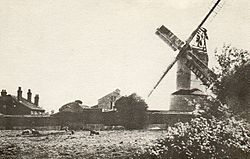Ramsey Windmill, Essex facts for kids
Quick facts for kids Ramsey Mill |
|
|---|---|

The mill in working order, c1920
|
|
| Origin | |
| Mill name | Ramsey Mill |
| Mill location | TM 209 304 |
| Coordinates | 51°55′44″N 1°12′47″E / 51.929°N 1.213°E |
| Operator(s) | Private |
| Year built | 1842 |
| Information | |
| Purpose | Corn mill |
| Type | Post mill |
| Storeys | Three storeys |
| Roundhouse storeys | Three storey roundhouse |
| No. of sails | Four sails |
| Type of sails | Double Patent sails |
| Windshaft | Cast iron |
| Winding | Fantail |
| Fantail blades | Six blades |
| No. of pairs of millstones | Three pairs |
| Other information | Moved from Woodbridge, Suffolk |
Ramsey Windmill is a special type of old building called a post mill. It is located in Ramsey, Essex, England. This mill is very important, so it's listed as a Grade II* building. This means it's a historic place that needs to be protected. The mill has been carefully fixed up and restored.
Contents
History of Ramsey Windmill
How the Mill Came to Ramsey
Ramsey Windmill was not always in Ramsey. It was first built in Woodbridge, Suffolk. In Woodbridge, it was one of four mills on a place called Mill Hills. In 1842, a skilled mill builder named Henry Collins moved the entire mill to Ramsey.
Working Life and Restoration
The mill worked for many years, grinding grain into flour. It kept working until the time of the Second World War. After that, it was left alone and started to fall apart.
However, in 1974, the owner, Mr. Michael Organ, decided to fix it. He began the big job of restoring the mill. People from a group called the Suffolk Mills Group also helped. They worked on Ramsey Windmill between 1974 and 1978 to bring it back to life.
What Ramsey Windmill Looks Like
Understanding a Post Mill
Ramsey Windmill is a post mill. This means the whole top part of the mill, which holds the sails and machinery, can turn around. This allows the sails to face the wind no matter which way it blows. The mill also has a three-storey roundhouse at its base.
How the Mill Moves with the Wind
The mill used a special part called a fantail to turn itself into the wind. This fantail was on the roof. It had six blades, like a small propeller. When the wind blew, the fantail would spin and automatically turn the main part of the mill. This made sure the big sails always caught the most wind.
Sails and Grinding Stones
Ramsey Windmill has four large sails. These are called "double Patent sails." They are designed to work efficiently. Inside the mill, there are three pairs of millstones. These heavy stones are used to grind corn into flour. Two pairs are at the front, and one pair is at the back of the mill.
Inside the Mill: The Trestle and Body
The main support of the mill is called the trestle. It is made of strong oak wood. The central post is about 5.3 meters (17 feet 6 inches) long. It is about 68 centimeters (27 inches) wide at the bottom.
The roundhouse, which is the base of the mill, has three storeys. This was a common way to build mills in Suffolk. The main part of the mill, called the body, is about 4.9 meters (16 feet) long and 3.1 meters (10 feet 4 inches) wide. The entire mill stands about 14.8 meters (48 feet 6 inches) tall.
Mill Machinery Details
The mill has a large wooden wheel called the Head Wheel. It is about 2.2 meters (7 feet 3 inches) wide and has 90 teeth. This wheel helps power the grinding stones. It turns two pairs of millstones that grind from the top down.
There is also a cast-iron Tail Wheel, which is about 1.2 meters (4 feet) wide. This wheel powers a third pair of millstones. These stones grind from the bottom up. All these parts work together to turn the power of the wind into the power to grind grain.
Millers of Ramsey Windmill
Many people have worked as millers at Ramsey Windmill over the years. Here are some of them:
- Robert Brooks (1842 - 1870)
- Robert Brooks Jr (1870 - unknown)
- John Brooks (1887 - unknown)
- L Lungley (unknown - 1937)
- R M Scott (1939)
- Lee Buchan (2013)

